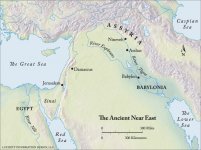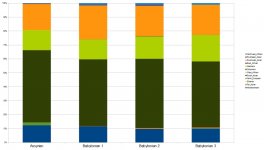oreo_cookie
Banned
- Messages
- 606
- Reaction score
- 27
- Points
- 0
Follow along with the video below to see how to install our site as a web app on your home screen.

Note: This feature currently requires accessing the site using the built-in Safari browser.
Could you precise me what do you mean by 'Assyrian'? Is it a religious minority in Syria or in surrounding lands?
Wikipedia on Assyrians (or in French if you'd prefer). They are a religiously diverse group, belonging to several Christian sects, and sometimes the term "Assyrian" takes a more narrow meaning to just mean those who are members of the Assyrian Church of the East. Autosomal DNA studies and anthropological studies tend to consistently show that they're basically the same group regardless of their religion, though, so the most common usage is to have "Assyrian" be the umbrella term used for Church of the East members, Chaldean Catholics, the Syriac Orthodox, etc.
If you're interested in learning more, I suggest you contact occasional Eupedia commenter Humanist, who is an expert. I can help as well, having done some research and having Chaldean & Syriac Catholic in-laws.
t is important to draw attention to the fact that the Aramaic-speaking peoples of the Near East have since ancient times identified themselves as Assyrians and still continue to do so. The self-designations of modern Syriacs and Assyrians, Sūryōyō and Sūrāyā, are both derived from the ancient Assyrian word for "Assyrian", Aššūrāyu, as can be easily established from a closer look at the relevant words.
The word Aššūrāyu is an adjective derived from the geographical and divine name Aššur with the gentilic suffix -āyu. This name was originally pronounced [Aššūr], with a palato-alveolar fricative, but owing to a sound shift, its pronunciation was turned to [Aθθūr] in the early second millennium BC. The common Aramaic word for Assyria, Āθūr, reflects this pronunciation and in all probability dates back to the twelfth century BC, when the Aramean tribes first came into contact with the Assyrians. Towards the end of the second millennium, another sound shift took place in Assyrian, turning the pronunciation of the name into [Assūr]. Since unstressed vowels and even whole syllables were often dropped in Neo-Assyrian at the beginning of words, this name form later also had a shorter variant, [Sūr], attested in alphabetic writings of personal names containing the element Aššur in late seventh century BC Aramaic documents from Assyria. The Neo-Assyrian word [Assūrāyu], “Assyrian”, thus likewise had a shorter variant [Sūrāyu] in the seventh century. This variant is hidden behind standard orthography in Assyrian cuneiform texts, but its existence is confirmed by the classical Greek words for Assyrians and Assyria, which display a corresponding variation between forms with initial A- (Assúrios/Assuría) and ones without it (Súrios/Súros/Suría; see AppendixIII).The Greeks, who were in frequent contact with Assyria in the eighth and seventh centuries BC,57 would not have borrowed the word without the initial A-, had the Assyrians themselves not omitted it, since omission of initial vowels is not a feature of classical Greek phonology.
Phonologically, Modern Assyrian Sūrāyā perfectly agrees with Neo-Assyrian [Sūrāyu], while Syriac Sūryōyō displays an intrusive yod, which it shares with Greek Súrios and Suría. This intrusive yod surely is due to Greek influence, since in classical Syriac the word also occurs in the form Sūrōyō, in perfect agreement with the Modern Assyrian Sūrāyā. It is worth noting that Sūrāyā is reported to have a variant with initial A-, but this is avoided in careful speech, since it instinctively sounds incorrect in view of the classical Syriac Sūryōyō. Since omission of initial vowels is not a feature of Aramaic phonology, the lack of the initial A- in Sūrāyā/Sūrōyō cannot be due to internal Aramaic development but must go back directly to Neo-Assyrian.
Footnotes:
[Assūr] ~ [Sūr] has a perfect parallel in the NA forms of another important divine name, Ištar (NA [Iššār]), which was also realized as [Šār] in Neo-Assyrian, see PNA 1/I, xxv. As in the case of [Sūr], the short form [Šār] is effectively concealed behind the prodominantly logographic or ossified cuneiform spellings of the divine name ((d)15, dINNIN, dIŠ.TAR), but its existence is raised beyond any doubt by the NA spellings of the Urartian royal name Sarduri [Šārdūri], which is written varyingly as m(d)15-du-ri, mdINNIN-du-ri or msa-ar-du-ri in the Neo-Assyrian royal inscriptions (see PNA 2/I 568f; note also the spelling URU.15-BÀD-a-ni = Sarduriani in ABL 147 = SAA 5 97 r.11). The “rebus” spellings m(d)15-du-ri and mdINNIN-BÀD/du-ri, implying the short form [Šār], are already attested in several inscriptions of Tiglath-Pileser III from c. 740 BC, and continue to be found in the letters and inscriptions of Sargon II (721-705) and Assurbanipal (668-630; for the latter, note m15-BÀD LUGAL KUR.ur-arţi in Streck 1916, 84:40, and mdI[Š.TAR-du-r]i LUGAL KUR.ú-ra-ar-ţi-im-[ma], ABL 1240:4-5). Like [Sūr], the short form [Šār] is also explicitly attested in Aramaic alphabetic spelling (cf. šrdrq’l = md15–BÀD-qa-a-li [Iššār-dūr-qāli], AECT 31) and in NB spellings of the Neo-Assyrian name Issār-tarība (mdiš-šar–ta-ri-bi, mdiš-šár–ta-ribi, mšar–ta-ri-bi, mdšár–ta-ri-bi, md15–ta-ri-bi, and mdIŠ.TAR–ta-ri-bi, all referring tothe same person), see Zadok 1984, 4.
In sum, the evidence adduced above demonstrates that the dialects of Modern Assyrian are unlikely to be direct descendants of the literary Syriac language,although they are undoubtedly related to it. Rather they existed side-by-side with it for centuries. Some of the features of the modern spoken dialects that differ from literary Syriac can be shown to have emerged at a much earlier period by the fact that they occasionally surface in written texts by a process of linguistic interference. Some features of morphology, moreover, are typologically more archaic than the corresponding features in Syriac. Likewise, some lexical items of the modern dialects are not attested in Syriac but have roots that can be traced to antiquity in the Akkadian language.
As already shown by Krotkoff (1985:124–126), a number of lexical items in the NENA [NortheasternNeo-Aramaic] dialects, especially those relating to agriculture, canbe traced back beyond Classical Aramaic to Akkadian or even Sumerian.

Mandaic is the term for the Aramaic dialect of the last remaining non-Christian Gnostics from Late Antiquity, the Mandaeans of Iraq and Iran (Ḵuzestān). It belongs to the Southeastern Aramaic dialect group with Babylonian Talmudic Aramaic (Babylonian Jewish Aramaic) and Koiné Babylonian Aramaic. Mandaic can be considered with its pre-classical text corpus (magic literature) as one of the purest Late Aramaic dialects of the Southeastern branch (Nöldeke, 1875, p. VI) comparable to Christian Palestinian Aramaic of the Western branch.
Mandaic inherited abundantly phonetic,grammatical, and lexicographic features from Akkadian (Late Babylonian) that point to the fact that the Mandaeans’ origin cannot have been anywhere else than in Mesopotamia (Kaufman, 1974,pp. 163-64; Müller-Kessler, 2004).
In the area of loanwords, Mandaic inherited from Akkadian an abundance of termini technici concerning religion, but also many words in other areas. Despite the limitationin its attested lexicon, due to the loss of texts, Mandaic shows more Akkadian borrowings than any other Aramaic dialect. The Mandaean gnostic sect recruited from a Babylonian population, and a stock of Akkadian words had belonged to the idiom of that geographical area for some centuries.

ASY1 12 0 0 2 0 0 52 14 0 19 0 0
BAB1 12 0 0 0 0 0 48 14 0 24 0 1
BAB2 10 0 0 0 0 0 50 16 0 22 1 1
BAB3 10 0 0 0 0 0 47 19 0 22 0 1They are very homogeneous, it is difficult to correspond with others.
I would have thought homogenity would have made it easier to answer.
I saw many red heads in Kurdistan and Mosul and surrounding areas I don't know if this a Kurdish thing or not below are some pics I took in Kurdistan just up the road from Mosul
This thread has been viewed 10243 times.
